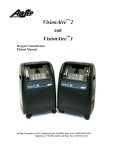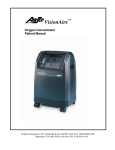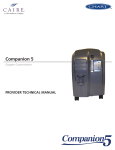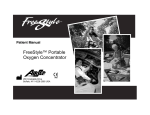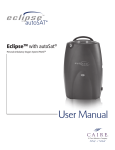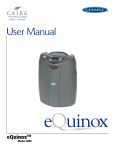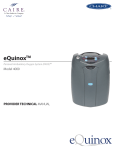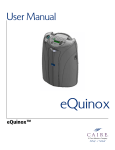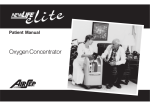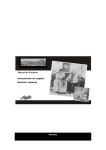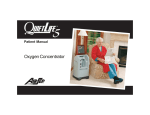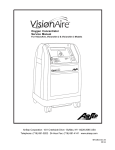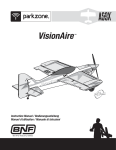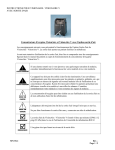Download User Manual - Chart Industries
Transcript
User Manual VisionAire 2 & 3 User Controls & System Status Indicators Symbol Definition Symbol Definition Read user manual before operation. See user manual for instructions. ON (power switch on) No Smoking Icon: Do not smoke near unit. OFF (power switch off) Warnings and Cautions No serviceable parts inside. Do not open cover. Type B equipment (degree of protection against electric shock) Class II equipment Complies with the 93/42/EEC directive drawn up by the approved organization No. 0459 Safety agency for CAN/CSA C22.2 No. 601.1 M90 for medical electrical equipment Keep unit and accessories dry Use no oil or grease. Consult the accompanying documents This symbol is to remind the equipment owners to return it to a recycling facility at the end of its life, per Waste Electrical and Electronic Equipment (WEEE) Directive. Proper disposal of waste of electrical and electronic equipment required. Oxygen outlet connection to the cannula Do not expose to open flames Caution: Federal law (USA) restricts this for sale or rental by or on the order of a physician or licensed health care provider. Keep in the vertical position Fragile – handle with care Oxygen concentration warning LED Date of Manufacture Name and address of manufacturer Serial number Authorized representative in the European Community Catalog number 2 — MN165-1 H Contents User Controls & System Status Indicators........................................................... 2 Indications for Use................................................................................................. 4 Contraindications for Use...................................................................................... 4 Safety Guidelines................................................................................................... 4 Introduction............................................................................................................ 8 Concentrator Components.................................................................................... 9 Operating Instructions......................................................................................... 12 Care and Cleaning................................................................................................ 13 Troubleshooting.................................................................................................... 14 Product Specifications......................................................................................... 15 Disposal................................................................................................................. 19 English: A multilingual version of the manual is available through your equipment provider. Español: Una versión multilingüe del manual está disponible a través de su proveedor de equipo. Français: Une version multilingue du manuel est disponible par l’intermédiaire de votre fournisseur de matériel. Deutsche: Eine mehrsprachige Version des Handbuchs ist in Ihrer Geräte-Anbieter VisionAire 2 & 3 User Manual — 3 Important! Safety Instructions are defined as follows: WARNING: IMPORTANT SAFETY INFORMATION FOR HAZARDS THAT MIGHT CAUSE SERIOUS INJURY. CAUTION: Important information for preventing damage to the VisionAire. Note: Information needing special attention. Indications for Use WARNING: It is very important to select only the prescribed level of oxygen. Do not change the flow selection unless you have been directed to do so by a licensed clinician. The portable Oxygen Concentrator may be used during sleep under the recommendation of a qualified clinician. WARNING: Federal (USA) law restricts this device to sale or rental by order of a physician or other licensed health care provider. WARNING: This unit is not to be used for life support. Geriatric, pediatric, or any other patient unable to communicate discomfort while using this device may require additional monitoring. Patients with hearing and/or sight impairment(s) may need assistance with monitoring alarms. Contraindications for Use WARNING: IN CERTAIN CIRCUMSTANCES, THE USE OF NON-PRESCRIBED OXYGEN CAN BE HAZARDOUS. THIS DEVICE SHOULD ONLY BE USED WHEN PRESCRIBED BY A PHYSICIAN. WARNING: NOT FOR USE IN THE PRESENCE OF FLAMMABLE ANESTHETICS. WARNING: AS WITH ANY ELECTRICALLY POWERED DEVICE, THE USER MAY EXPERIENCE PERIODS OF NON-OPERATION AS A RESULT OF ELECTRICAL POWER INTERRUPTION, OR THE NEED TO HAVE THE VisionAire SERVICED BY A QUALIFIED TECHNICIAN. THE VisionAire IS NOT APPROPRIATE FOR ANY PATIENT WHO WOULD EXPERIENCE ADVERSE HEALTH CONSEQUENCES AS THE RESULT OF SUCH TEMPORARY INTERRUPTION. Safety Guidelines WARNING: No modification of this equipment is permitted WARNING: Smoking while using oxygen is the number one cause of fire, injury, and death. You must follow these safety warnings: WARNING: Do not allow smoking, candles, or open flames within the same room of the device or the oxygen-carrying accessories. WARNING: Smoking while wearing an oxygen cannula can cause facial burns and possibly result in death. WARNING: Removing the cannula and placing it on clothing, bedding, sofas, or other cushion material will cause a flash fire when exposed to a cigarette, heat source, spark or open flame. WARNING: If you smoke, you must always follow these 3 important steps first: turn off the oxygen concentrator, take off the cannula, and leave the room where this device is located. CAUTION: Federal (USA) law restricts this device to sale or rental by order of a physician or other licensed health care provider. WARNING: This device supplies high-concentration oxygen that promotes rapid burning. Do not allow smoking or open flames within the same room of (1) this device, or (2) any oxygen-carrying accessory. Failure to observe this warning can result in severe fire, property damage and / or cause physical injury or death. WARNING: Do not use your oxygen concentrator in the presence of flammable gases. This can result in rapid burning causing property damage, bodily injuries or death. WARNING: Do not leave a nasal cannula on clothing, bed coverings or chair cushions. If the unit is turned on but not in use, the oxygen will make the material flammable. Set the I/0 power switch to the 0 (Off) position when the Oxygen Concentrator is not in use. WARNING: Use no oil, grease, or petroleum-based or other flammable products with the oxygen-carrying accessories or the Oxygen Concentrator. Only water based, oxygen compatible lotions or salves should be used. Oxygen accelerates the combustion of flammable substances. WARNING: Clean the cabinet, control panel, and power cord only with a mild household cleaner applied with a damp cloth (not wet) or sponge, and then wipe all surfaces dry. Do not allow any liquid to get inside the device. Note: Portable and mobile RF communications equipment can effect medical electrical equipment. 4 — MN165-1 H WARNING: Do not attempt any maintenance other than the possible solutions listed within this manual. Do not remove covers, only your Equipment Provider or a qualified service technician should remove the covers or service this device. WARNING: Only accessories recommended by the manufacturer. Use of any other may be hazardous, cause serious damage to your oxygen concentrator and will void the warranty . WARNING: The Manufacturer recommends an alternate source of supplemental oxygen in the event of a power outage, alarm condition, or mechanical failure. Consult your physician or Equipment Provider for the type of reserve system required. WARNING: Do not allow either the air intake or the air outlet vents to become blocked. DO NOT drop or insert any objects into any openings on the device. This can cause the Oxygen Concentrator to overheat and impair performance. CAUTION: In the event of an alarm or you observe the Oxygen Concentrator is not working properly; consult the Troubleshooting section in this manual. If you cannot resolve the problem, consult your Equipment Provider. CAUTION: To prevent a void warranty, follow all manufacturers’ instructions. WARNING: Electrical shock hazard. Turn Off the unit and disconnect the power cord from the electric outlet before you clean the unit to prevent accidental electrical shock and burn hazard. Only your Equipment Provider or a qualified service technician should remove the covers or service the unit. WARNING: Care should be taken to prevent the Oxygen Concentrator from getting wet or allowing fluids to enter the unit. This can cause the unit to malfunction or shut down, and cause an increased risk for electrical shock or burns. WARNING: Do not use liquid directly on the unit. A list of undesirable chemical agents includes but is not limited to the following: alcohol and alcohol-based products, concentrated chlorine-based products (ethylene chloride), and oil-based products (Pine-Sol®, Lestoil®). These are NOT to be used to clean the plastic housing on the Oxygen Concentrator, as they can damage the unit’s plastic. WARNING: Smoking while using oxygen is the number one cause of fire injuries and related deaths. You must follow these safety warnings: WARNING: Do not allow smoking, candles, or open flames in the same room with the device or the oxygen-carrying accessories. WARNING: Smoking while wearing an oxygen cannula may cause facial burns and possibly death. WARNING: If you smoke, these 3 steps may save your life: turn off the oxygen concentrator, take off the cannula, and leave the room where this device is located. WARNING: “No Smoking – Oxygen in Use” signs must be prominently displayed in the home, or where oxygen is in use. Patients and their caregivers must be informed about the dangers of smoking in the presence of, or while using, medical oxygen. WARNING: Do not use your oxygen concentrator in the presence of flammable gases. This can result in rapid burning causing property damage, bodily injuries or death. WARNING: Removing the cannula and putting it on clothing, bedding, sofas, or other cushion material will cause a flash fire when exposed to a cigarette, heat source, or flame. WARNING: Do not leave a nasal cannula on or under clothing, bed coverings or chair cushions. If the unit is turned on but not in use, the oxygen will make the material flammable. Set the OXYGEN CONCENTRATOR to the 0 (Off) position when the Oxygen Concentrator is not in use. CAUTION: Always place oxygen supply tubing and power cords in a manner that prevents a trip hazard. WARNING: The Oxygen Concentrator should not be used adjacent to or stacked with other equipment. If adjacent or stacked use is unavoidable, the device should be observed to verify normal operation. WARNING: No modification of this equipment is permitted. WARNING: Use of cables and adapters other than those specified, with the exception of cables and adapters sold by the manufacturer of the medical electrical equipment as replacement parts for internal components, may result in increased emissions of decreased immunity of the Oxygen Concentrator. WARNING: Use only electrical voltage as specified on the specification label affixed to the device. WARNING: Do not use extension cords with this unit or connect too many plugs into the same electrical outlet. The use of extension cords could adversely affect the performance of the device. Too many plugs into one outlet can result in an overload to the electrical panel causing the breaker/fuse to activate or fire if the breaker or fuse fails to operate. VisionAire 2 & 3 User Manual — 5 AVERTISSEMENT: Cet appareil produit de l’oxygène à concentration élevée, favorisant une combustion rapide. Ne pas permettre de fumer ou des flammes nues dans la même chambre: (1) cet appareil ou (2) tout accessoire contenant de l’oxygène. Ne pas utiliser de produits à base d’huile, de graisse ou de pétrole sur ou à proximité de l’unité. Déconnecter le cordon d’alimentation de la prise électrique avant de nettoyer ou de faire l’entretien de l’unité. AVERTISSEMENT: Risque de choc électrique. Ne pas enlever les couvercles lorsque l’unité est branchée. Seuls votre fournisseur d’équipement ou un technicien de service qualifié devrait enlever les couvercles ou faire l’entretien de l’unité. WARNING: The Oxygen Concentrator should not be used adjacent to or stacked with other equipment. If adjacent or stacked use is unavoidable, the device should be observed to verify normal operation. WARNING: No modification of this equipment is permitted. WARNING: Use of cables and adapters other than those specified, with the exception of cables and adapters sold by the manufacturer of the medical electrical equipment as replacement parts for internal components, may result in increased emissions of decreased immunity of the Oxygen Concentrator. WARNING: Use only electrical voltage as specified on the specification label affixed to the device. WARNING: Do not use extension cords with this unit or connect too many plugs into the same electrical outlet. The use of extension cords could adversely affect the performance of the device. Too many plugs into one outlet can result in an overload to the electrical panel causing the breaker/fuse to activate or fire if the breaker or fuse fails to operate. CAUTION: Do not position the unit so that it is difficult to access the power cord. CAUTION: The concentrator should be located as to avoid smoke, pollutants or fumes. CAUTION: Ensure concentrator is operated in an upright position. CAUTION: Always place oxygen supply tubing and power cords in a manner that prevents a trip hazard. CAUTION: Position the unit away from curtains or drapes, hot air registers or heaters. Be certain to place the unit on a flat surface and make sure all sides are at least 1 foot (30 cm) away from a wall or other obstruction. Do not place the unit in a confined area. Choose a dust and smoke free-location away from direct sunlight. Do not operate the unit outdoors unless the unit is plugged into a Ground Fault Circuit Interrupter (GFCI) protected outlet. CAUTION: Do not operate this unit in a restricted or confined space where ventilation can be limited. This can cause the device to overheat and affect performance. CAUTION: Do not allow either the air intake or the air outlet vents to be blocked. DO NOT drop or insert any object into any openings on the device. This can cause the Oxygen Concentrator to overheat and impair performance. CAUTION: The Manufacturer recommends an alternate source of supplemental oxygen in the event of a power outage, alarm condition, or mechanical failure. Consult your physician or Equipment Provider for the type of reserve system required. CAUTION: It is very important to select only the prescribed level of oxygen. Do not change the flow selection unless you have been directed to do so by a licensed clinician. CAUTION: The Oxygen Concentrator may be used during sleep under the recommendation of a licensed clinician. CAUTION: Operating or storing the Oxygen Concentrator outside of its normal operating temperature range can impair the performance of the unit. Refer to the specification section of this manual for storage and operating temperature limits. CAUTION: In the event of an alarm or you observe the Oxygen Concentrator is not working properly; consult the troubleshooting section of this manual. If you cannot resolve the problem, consult your Equipment Provider. CAUTION: If the audio alarm is weak or does not sound at all, consult your Equipment Provider immediately. CAUTION: For units equipped with the oxygen monitor option - Contact your Equipment Provider immediately if the amber OXYGEN MONITOR light remains on for more than 15 minutes and/or the audio alarm activates. CAUTION: If the humidifier bottle tubing is not properly connected to the humidifier bottle fitting or to the oxygen outlet, an oxygen leak can occur. 6 — MN165-1 H Note: Cannula must be non-kinking, which can be used for a total length of 25 ft. (7.6 m) max. Note: Ensure the cannula is fully inserted and secure. You should hear or feel oxygen flow to the prongs of the nasal cannula. If oxygen does not seem to flow, first verify that the flowmeter ball is registering a flow. Then, place the tip of the cannula into a glass of water; if bubbles come out of the cannula, oxygen is flowing. If bubbles do not appear, refer to the troubleshooting section of this manual. Note: Always follow the cannula manufacturer’s instructions for proper use. Replace the disposable cannula as recommended by the cannula manufacturer or your Equipment Provider. Additional supplies are available from your Equipment Provider. Note: AirSep offers the OxySafe as an optional accessory. This is intended to be used in conjunction with the Visionaire 2/3 concentrator. For customers in regions requiring compliance to EN ISO 8359:1996-Ammendment1:2012, this accessory will meet this need. The OxySafe is a thermal fuse to stop the flow of gas in the event that the downstream cannula or oxygen tubing is ignited and burns to the OxySafe. It is placed in-line with the nasal cannula or oxygen tubing between the patient and the oxygen outlet of the Visionaire 2/3. For proper use of the OxySafe, always refer to the manufacturer’s instructions (included with each OxySafe kit). AirSep offers an OxySafe kit that includes OxySafe with 2” of tubing to connect to the oxygen outlet; PN 20629671 Note: The use of some oxygen administration accessories not specified for use with this oxygen concentrator may impair its performance. Recommended accessories are referenced within this manual. Note: To Equipment Provider: The following oxygen administration accessories are recommended for use with the Oxygen Concentrator • Humidifier Bottle: Part No. HU003-1 • Nasal Cannula with 7 feet (2.1 m) of tubing: Part No. CU002-1 • OxySafe Kit: Part No. 20629671 Note: The Manufacturer does not recommend the sterilization of this equipment. Note: If the unit has not been used for an extended time period, it needs to operate for a minimum of several minutes before power failure alarm can become activated. Note: For units equipped with the oxygen monitor option When you turn the unit on, it’s normal for the amber OXYGEN MONITOR light to turn on and remain on for up to five minutes. Note: The concentrator releases warm air out the bottom of the unit which can permanently discolor temperature sensitive flooring surfaces such as vinyl. The concentrator should not be used over flooring that is sensitive to heat staining. The Manufacturer is not responsible for flooring that becomes discolored. Note: To prevent a void warranty, follow all manufacturers’ instructions. Note: Do not attempt any maintenance other than the possible solutions listed within the manual. Note: Portable and mobile RF communications equipment can effect medical electrical equipment. Note: There is never a danger of depleting the oxygen in a room when you use your Oxygen Concentrator unit. VisionAire 2 & 3 User Manual — 7 Introduction This Patient Manual will acquaint you with AirSep’s VisionAire 2 and VisionAire 3 Oxygen Concentrators. Make sure you read and understand all of the information contained in this guide before operating your concentrator. Should you have any questions, your Equipment Provider will be happy to answer them for you. Why Your Physician Prescribed Oxygen Many people today suffer from a variety of heart, lung, and other respiratory diseases. A significant number of these patients can benefit from supplemental oxygen therapy for respiratory care at home, in the hospital, or at a medical facility. Oxygen is a gas that makes up 21% of the room air we breathe. Our bodies depend on a steady supply to function properly. Your physician has prescribed supplemental oxygen therapy because your body is not able to get enough oxygen from room air. Oxygen is a non-addictive drug, and your physician prescribed a flow sufficient to improve your condition. Please keep in mind that unauthorized oxygen therapy can be dangerous. You must seek medical advice before you use this unit. The Equipment Provider who supplies your oxygen equipment will demonstrate how to set the prescribed flow rate. What is an Oxygen Concentrator? Oxygen concentrators were introduced in the mid1970s and have become the most convenient, reliable source of supplemental oxygen available today. Without an oxygen concentrator, the average patient would require a delivery of 12 bottles/cylinders of oxygen each month. Your oxygen concentrator produces all the oxygen you need, with no deliveries required. The air we breathe contains approximately 21% oxygen, 78% nitrogen, and 1% other gases. In the VisionAire 2 or VisionAire 3 unit, room air passes through a regenerative adsorbent material called molecular sieve. This material separates the oxygen from the nitrogen and other gases. The result is a constant supply of high concentration supplemental oxygen that is delivered to the patient. Note: There is never a danger of depleting the oxygen in a room when you use your VisionAire 2 or VisionAire 3 unit. 8 — MN165-1 H Operator Profile: AirSep’s Stationary Concentrators are intended to supply supplemental Oxygen to users suffering from discomfort due to ailments which affect the efficiency of ones lungs to transfer the oxygen in air to their bloodstream. Users can benefit from supplemental oxygen therapy for respiratory care at home, in the hospital, or at a medical facility. Oxygen Concentrator use requires a physician’s prescription, and are not intended for life support use. Although Oxygen therapy can be prescribed for patients of all ages the typical oxygen therapy patient is older than 65 years of age and suffers from chronic obstructive pulmonary disease (COPD). Patients typically have good cognitive abilities and must be able to communicate discomfort. If the user is unable to communicate discomfort, or unable to read and understand the concentrator labeling and instructions for use, then use is recommended only under the supervision of one who can. If any discomfort is felt while using the concentrator, patients are advised to contact their healthcare provider. Patients are also advised to have back-up oxygen available (i.e. cylinder oxygen) in the event of a power outage or concentrator failure. There are no other unique skills or user abilities required for concentrator use. Concentrator Components Review the figures below and become familiar with the important parts of your VisionAire 2 or VisionAire 3 Oxygen Concentrator. Front of Concentrator Top Handle Hour Meter Oxygen Outlet Side Handle(s) Circuit Breaker Reset Button Flowmeter Adjustment Knob Low Oxygen Concentration Indicator (optional – mandated for EU and specific countries) ON/OFF (I/0) Power Switch Operating Instructions Label Specification Label Caster(s) Top and Side Handles: Enables convenience in carrying the unit. On/Off (I/0) Power Switch: Starts and stops the operation of the unit. Low Oxygen Concentration Indicator (optional – mandated for EU and specific countries): When equipped with an Oxygen Monitor – a warning LED (amber) is activated on the front panel (see ‘Safety Features’ for details). Oxygen Outlet: Provides connection for a humidifier (if required) or cannula. Hour Meter: Records the concentrator’s cumulative hours of operation. Circuit Breaker Reset Button: Resets the unit after electrical overload shutdown. Operating Instructions Label: Directs usage of the unit. Flowmeter Adjustment Knob: Controls the oxygen flow rate in liters per minute (LPM). Casters: Four casters enable unit to be easily moved, as needed. Specification Label: Displays electrical specifications and serial number. VisionAire 2 & 3 User Manual — 9 Humidifier Bottle (optional) Humidifier Bottle Recess Humidifier Bottle Fitting Humidifier Bottle Tubing Back of Concentrator Humidifier Bottle Oxygen Outlet Humidifier Bottle Oxygen Tubing/Cannula Power Cord Power Cord: Allows connection of the unit to an electrical outlet. Humidifier Bottle (optional): Humidifies the oxygen before it reaches the patient. Humidifier Bottle Recess: Area to place the optional humidifier bottle. Humidifier Bottle Oxygen Outlet: Connection for oxygen tubing/cannula. 10 — MN165-1 H Accessories Safety Features Recommended for use with VisionAire 2 and VisionAire 3. The use of certain administration accessories which are not specified for use with this concentrator may reduce performance and void the manufacturer’s warranty. Item PN Humidifier Bottle HU003-1 Cannula, 25 feet (7.6 m) CU002-4 Cannula, 7 feet (2.1 m) CU002-1 Humidifier Bottle Tubing TU176-160 Humidifier Bottle Fitting F0655-1 Oxygen Tubing, 25 feet (7.6 m) CU004-3 Tubing/Cannula Connector CU009-1 OxySafe Kit 20629671 Part Safety Feature Compressor Motor Thermal safety is ensured by a thermostat situated in the stator winding (135°C/ 275 °F). A safety relief valve is fitted to the compressor outlet and is calibrated to 280 kPa (40 psig). Power Failure In the event the unit is operating and a loss of power occurs, an audible single - pulse intermittent alarm will activate. Oxygen Monitor The oxygen monitor detects any drop in concentration below 82% (±3%) and activates a visual alarm (amber LED indicator on front panel). If the concentration continues to operate below 82%, an audible 2-pulse intermittent alarm will also activate. Hi Pressure An over-pressure safety feature prevents potential damage to device components at a pressure of 207 kPa (30 psig (± 2 psig). An audible 4-pulse intermittent alarm will activate. Low Pressure An audible 3-pulse intermittent alarm will activate if the device pressure reduces to ≤ 35 kPa (5 psig (± 1 psig). No Flow Warning An obstruction to the flow of oxygen, such as a pinch or kink in the delivery cannula, will activate an audible 6- pulse intermittent alarm. Product Filter ≥ 10 micron Materials in direct or indirect contact with patient Item Concentrator Cabinet (all parts) Gas Outlet, Nozzle On / Off Switch Hour Meter Flowmeter Gas Outlet Circuit Breaker Unit Labels Power Cord Cord Strain Relief Cord Wrap Dust Filter Humidifier Strap Humidifier Bottle Cannula (Tubing) Material NOVA PS6201 Super High Impact Polystyrene Aluminum, Black Anodized DuPont FR50 Acrylonitrile Butadiene Styrene (ABS) Plastic & Acrylic ABS (STAT-TECH AS1000) Brass Button - Melamine or Urea Formaldehyde, Mounting Bushing – Polyamide 66 (Nylon) Lexan Polyvinyl Chloride (PVC), Metal Nylon Velcro Polyester Yarn, Rubber Top – Acrylonitrile Butadiene Styrene (ABS) Bottle – Polypropylene (PP) Diffuser -Polyvinyl Chloride (PVC) Polyvinyl Chloride (PVC) VisionAire 2 & 3 User Manual — 11 Operating Instructions Review the following information before you operate your oxygen concentrator. Note: The concentrator releases warm air out the bottom of the unit which can permanently discolor temperature sensitive flooring surfaces such as vinyl. The concentrator should not be used over flooring that is sensitive to heat staining. The manufacturer is not responsible for flooring that becomes discolored. Humidifier Bottle Connection (Optional) If additional humidification is required with your oxygen therapy, perform the following steps each time you fill or clean the humidifier, which may have been initially set up for your use. 1. Remove the humidifier bottle from the humidifier bottle recess. 2. Open the humidifier bottle. If you have a pre-filled bottle, do not perform this step. Proceed to step 5. 3. Fill the humidifier bottle with cool or cold water (distilled water is preferred) to the fill line indicated on the bottle. DO NOT OVERFILL. 4. Re-connect the top cover to the humidifier bottle. 5. Place the humidifier bottle in the humidifier bottle recess on the back of the concentrator and connect the humidifier bottle tubing to the oxygen outlet and the humidifier bottle fitting. CAUTION: If the humidifier bottle tubing is not properly connected to the humidifier bottle fitting or to the oxygen outlet, an oxygen leak can occur. Cannula Connection Connect the tubing and cannula to the unit’s oxygen outlet, or to the optional humidifier’s oxygen outlet. Starting the Concentrator WARNING: “No Smoking – Oxygen in Use” signs must be prominently displayed in the home, or where oxygen is in use. Patients and their caregivers must be informed about the dangers of smoking in the presence of, or while using, medical oxygen. WARNING: Do not use extension cords with this unit or connect too many plugs into the same electrical outlet. The use of extension cords could adversely affect the performance of the device. Too many plugs into one outlet can result in an overload to the electrical panel causing the breaker/fuse to activate or fire if the breaker or fuse fails to operate. CAUTION: Position the unit away from curtains or drapes, hot air registers or heaters. Be certain to place the unit on a flat surface and make sure all sides are at least 1 foot (30 cm) away from a wall or other obstruction. Do not place the unit in a confined area. Choose a dust and smoke free-location away from direct sunlight. Do not operate the unit outdoors unless the unit is plugged into a Ground Fault Interrupter (GFI) protected outlet. 1.Locate the unit near the electrical outlet in the room where you spend most of your time. 2.Insert the power cord plug into the electrical outlet. 3.Set the I/0 power switch to the “I” position to turn the unit on. An audible alarm will loudly sound for approximately 5 seconds. 4.The low oxygen concentration indicator remains on for a few minutes and until the oxygen concentration reaches minimum concentration requirements, (only pertains to unit equipped with an Oxygen Monitor) 5.To set the flow of supplemental oxygen, turn the flowmeter adjustment knob left or right until the ball inside the flowmeter centers on the flow line number prescribed by your physician. To view the flowmeter at the proper angle, note that the back line and the front number line must give appearance of one line. 6.The concentrator is now ready for use. Note: Optimal oxygen concentration is obtained within 10 minutes after the device is switched on (90% of the concentration is obtained after approximately 5 minutes). 12 — MN165-1 H CAUTION: It is very important to select only the prescribed level of oxygen. Do not change the flow selection unless you have been directed to do so by a licensed clinician. Normally, you should not need to adjust the flowmeter on your unit. If you turn the flowmeter adjustment knob clockwise, you will decrease and can shut off the flow of oxygen from your unit. Note: Ensure the cannula is fully inserted and secure. You should hear or feel oxygen flow to the prongs of the nasal cannula. If oxygen does not seem to flow, first verify that the flowmeter ball is registering a flow. Then, place the tip of the cannula into a glass of water; if bubbles come out of the cannula, oxygen is flowing. If bubbles do not appear, refer to the troubleshooting section of this manual. CAUTION: Ensure concentrator is operated in an upright position. Turning the Concentrator Off Set the I/0 power switch to the “0” position to turn off the unit. Care and Cleaning WARNING: Electrical shock hazard. Turn Off the unit and disconnect the power cord from the electric outlet before you clean the unit to prevent accidental electrical shock and burn hazard. Only your Equipment Provider or a qualified service technician should remove the covers or service the unit. WARNING: Care should be taken to prevent the Oxygen Concentrator from getting wet or allowing fluids to enter the unit. This can cause the unit to malfunction or shut down, and cause an increased risk for electrical shock or burns. WARNING: Do not use liquid directly on the unit. A list of undesirable chemical agents includes but is not limited to the following: alcohol and alcohol-based products, concentrated chlorine-based products (ethylene chloride), and oil-based products (Pine-Sol®, Lestoil®). These are NOT to be used to clean the plastic housing on the unit, as they can damage the unit’s plastic. WARNING: Clean the cabinet, control panel, and power cord only with a mild household cleaner applied with a damp cloth or sponge, and then wipe all surfaces dry. Do not allow any liquid to get inside the device. Note: Always follow the cannula manufacturer’s instructions for proper use. Replace the disposable cannula as recommended by the cannula manufacturer or your Equipment Provider. Additional supplies are available from your Equipment Provider. Note: To prevent a voided AirSep warranty, follow all manufacturers’ instructions. Note: AirSep does not recommend the sterilization of this equipment. Humidifier Bottle (optional) Check water level daily and add water as needed To clean and disinfect the humidifier, follow your Equipment Provider’s instructions, or the instructions included with the humidifier bottle. Outside Cabinet Use a mild household cleaner applied with a damp cloth or sponge to clean the exterior of the concentrator, and then wipe all surfaces dry. Do not allow any liquids to enter the concentrator. VisionAire 2 & 3 User Manual — 13 Troubleshooting If your concentrator fails to operate properly, consult your Equipment Provider, and refer to the troubleshooting chart on the following pages for probable causes and solutions. Note: Do not attempt any maintenance other than the possible solutions listed within the manual Note: If the unit has not been used for an extended time period, it needs to operate for several minutes before power failure alarm can become activated. Problem Probable Cause Solution Unit does not operate. Power failure condition causes an alarm to sound. The power cord is not connected to the electrical outlet. Check power cord at the electrical outlet for a proper connection. No power at the electrical outlet. Check power source, wall switch, in-house fuse or circuit breaker. Circuit breaker on concentrator unit is activated. Press (do not hold in) the circuit breaker reset button in the front of the unit. Dirty or obstructed humidifier bottle, or leak present. Remove the humidifier bottle, and if flow is restored, clean or replace the humidifier bottle. Defective nasal cannula, or other oxygen accessories, i.e. oxygen tubing. Remove and check accessories for kinks or obstructions. Replace if needed. Limited or no oxygen flow. If the circuit breaker trips again or the alarm continues to sound after the unit is turned on, contact your Equipment Provider. Cannula tubing loose. Check cannula tubing connection at control panel. Condensation collects in the oxygen tubing when you use a humidifier bottle Unit not properly ventilated. Elevated operating temperatures. Make sure unit is positioned away from curtains or drapes, hot air registers or heaters. Be certain to place the unit so all sides are at least 1 foot (30 cm) away from a wall or other obstruction. Do not place the unit in a confined area. Refill humidifier bottle with COLD water. DO NOT OVERFILL. Allow oxygen tubing to dry out, or replace with new tubing. Intermittent alarm sounds at one second intervals. See “Safety Features” for a description of auditory indicators. Set I/0 power switch to 0 position, use your reserve oxygen supply (if provided), and consult your Equipment Provider immediately. Oxygen Concentration Indicator remains lit (amber) Oxygen concentration is ≤ 82% (±3%). Set I/0 power switch to the 0 position, use your reserve oxygen supply (if provided), and consult your Equipment Provider immediately. All other problems. 14 — MN165-1 H Set I/0 power switch to the 0 position, use your reserve oxygen supply (if provided), and consult your Equipment Provider immediately. Product Specifications For correct use of the device refer to the following chart. The chart provides important information about the recommended operating environments, or operating conditions. Specifications Flow Specifications(1) 1/2 lpm – 3 lpm 1/8 lpm – 2 lpm Oxygen Concentration(2) 90% (+ 5.5% / - 3%) Electrical Requirements 115 VAC / 60 Hz, 3.0 A 230 VAC / 50 Hz, 1.5 A 230 VAC/ 60 Hz, 1.0 A Power Consumption Sound Dimensions VisionAire 2 = 200 Watts (+/- 10%) VisionAire 3 = 200 Watts (+/- 10%) 45 dba anechoic 14.1 in. W x 11.5 in. D x 20.8 in. H (35.8 cm W x 29.2 cm D x 52.8 cm H) Weight 30 lbs (13.6 kg) Electrical Shock Protection Class II, Type B Environmental Limit Conditions(3) Operating conditions: 5°C to 40°C (41°F to 104°F) at altitudes up to 10,000 ft. (523 mmHg) above sea level. Storage: -20°C to 60°C (-4°F to 140°F) Relative Humidity: up to 95% RH non-condensing (1) ±10% of indicated setting, or 200 mL, whichever is greater (2) Performance based at 21°C (70°F) at nominal operating pressure range: 0-7 kPa (0-1 psig back pressure). Maximum outlet pressure : 55 kPa. ( 7.98 psig) (3) Operating outside of these operational specifications can limit the concentrators ability to meet Oxygen Concentration specification at higher liter flow rates. VisionAire 2 & 3 User Manual — 15 Medical equipment needs special precautions regarding EMC and need to be installed and put into service according to the EMC information provided in this section. Guidance and Manufacturer’s Declaration—Electromagnetic Immunity The unit is intended for use in the electromagnetic environment specified below. The customer or the user of the unit should assure that it is used in such an environment. Immunity test IEC 60601 test level Compliance level Electromagnetic environment – guidance ±6 kV contact ±6 kV contact ±8 kV air ±8 kV air ±2 kV for power supply lines ±2 kV for power supply lines IEC 61000-4-2 Electrical fast transient/burst IEC 61000-4-4 Surge IEC 61000-4-5 ±1 kV for input/output lines ±1 kV line(s) to line(s) Electromagnetic environment – guidance Floors should be wood, concrete or ceramic tile. If floors are covered with synthetic material, the relative humidity should be at least 30 %. Mains power quality should be that of a typical commercial or hospital environment. N/A ±1 kV line(s) to line(s) ±2 kV line(s) to earth Mains power quality should be that of a typical commercial or hospital environment. <5 % UT <5 % UT (>95 % dip in UT ) (>95 % dip in UT ) for 0,5 cycle for 0,5 cycle 40 % UT Voltage dips, short interruptions and voltage variations on power supply input lines IEC 61000-4-11 40 % UT (60 % dip in UT ) (60 % dip in UT ) for 5 cycles for 5 cycles 70 % UT 70 % UT (30 % dip in UT ) (30 % dip in UT ) for 25 cycles Mains power quality should be that of a typical commercial or hospital environment. If the user of the unit requires continued operation during power mains interruptions, it is recommended that the unit be powered from an uninterruptible power supply or a battery. for 25 cycles <5 % UT (>95 % dip in UT ) for 5 sec <5 % UT (>95 % dip in UT ) for 5 sec Power frequency (50/60 Hz) magnetic field IEC 61000-4-8 3A/m 3A/m Power frequency magnetic fields should be at levels characteristic of a typical location in a typical commercial or hospital environment. NOTE UT is the A.C. mains voltage prior to application of the test level. 16 — MN165-1 H Guidance and Manufacturer’s Declaration–Electromagnetic Immunity The unit is intended for use in the electromagnetic environment specified below. The customer or the user of the unit should assure that it is used in such an environment. Immunity test IEC 60601 test level Compliance level Electromagnetic environment – guidance Conducted RF 3 Vrms 3 Vrms IEC 61000-4-6 150 kHz to 80 MHz Portable and mobile RF communications equipment should be used no closer to any part of the VisionAire, including cables, than the recommended separation distance calculated from the equation applicable to the frequency of the transmitter. Radiated RF IEC 61000-4-3 3 V/m 3 V/m 80 MHz to 2,5 GHz Recommended separation distance d 1.2 P d 1.2 P = 80 MHz to 800 MHz d 1.2 P = 800 MHz to 2,5 GHz Where P is the maximum output power rating of the transmitter in watts (W) according to the transmitter manufacturer and d is the recommended separation distance in metres (m). Field strengths from fixed RF transmitters, as determined by an electromagnetic site survey,a should be less than the compliance level in each frequency range. b Interference may occur in the vicinity of equipment marked with the following symbol: NOTE 1 At 80 MHz and 800 MHz, the higher frequency range applies. NOTE 2 These guidelines may not apply in all situations. Electromagnetic propagation is affected by absorption and reflection from structures, objects and people. a Field strengths from fixed transmitters, such as base stations for radio (cellular/cordless) telephones and land mobile radios, amateur radio, AM and FM radio broadcast and TV broadcast cannot be predicted theoretically with accuracy. To assess the electromagnetic environment due to fixed RF transmitters, an electromagnetic site survey should be considered. If the measured field strength in the location in which the VisionAire is used exceeds the applicable RF compliance level above, the VisionAire should be observed to verify normal operation. If abnormal performance is observed, additional measures may be necessary, such as re-orienting or relocating the VisionAire. b Over the frequency range 150 kHz to 80 MHz, field strengths should be less than 3 V/m. VisionAire 2 & 3 User Manual — 17 Recommended separation distances between portable and mobile RF communications equipment and the unit The unit is intended for use in an electromagnetic environment in which radiated RF disturbances are controlled. The customer or the user of the unit can help prevent electromagnetic interference by maintaining a minimum distance between portable and mobile RF communications equipment (transmitters) and the unit as recommended below, according to the maximum output power of the communications equipment. Rated maximum output power of transmitter Separation distance according to frequency of transmitter m 150 kHz to 80 MHz 80 MHz to 800 MHz 800 MHz to 2,5 GHz W d 1.2 P d 1.2 P d 1.2 P 0,01 0.12 0.12 0.23 0,1 0.38 0.38 0.73 1 1.2 1.2 2.3 10 3.8 3.8 7.3 100 12 12 23 For transmitters rated at a maximum output power not listed above, the recommended separation distance d in metres (m) can be estimated using the equation applicable to the frequency of the transmitter, where P is the maximum output power rating of the transmitter in watts (W) according to the transmitter manufacturer. NOTE 1 At 80 MHz and 800 MHz, the separation distance for the higher frequency range applies. NOTE 2 These guidelines may not apply in all situations. Electromagnetic propagation is affected by absorption and reflection from structures, objects and people. Guidance and Manufacturer’s Declaration—Electromagnetic Emissions The unit is intended for use in the electromagnetic environment specified below. The customer or the user of the unit should assure that it is used in such an environment. Emissions Test RF emissions CISPR 11 RF emissions CISPR 11 Compliance Electromagnetic Environment - Guidance Group 1 The unit uses RF energy only for its internal function. Therefore, its RF emissions are very low and are not likely to cause any interference in nearby electronic equipment. Class B Harmonic emissions IEC 61000-3-2 Class A Voltage fluctuations/ flicker emissions IEC 61000-3-3 Complies 18 — MN165-1 H The unit is suitable for use in all establishments, including domestic establishments and those directly connected to the public low-voltage power supply network that supplies buildings used for domestic purposes. Conformity with EN 60-601 (§ 6.8.2 b) / Classification: Disposal “The manufacturer, assembler, installer or importer are not considered to be responsible themselves for the consequences on the safety, reliability and characteristics of a device unless: - The assembly, fitting, extensions, adjustments, modifications or repairs have been performed by persons authorized by the party in question, - The electrical installation of the corresponding premises complies with IEC regulations. - The device is used in accordance with the instructions for use. “If the replacement parts used for the periodic servicing by an approved technician do not comply with the manufacturer’s specifications, the latter is absolved from all responsibility in the event of an accident. Do not open the device while in operation: risk of electrical shock. This device complies with the requirements of the MDD (93/42/ EEC:2007/47/EC) Annex I European directive but its operation may be affected by other devices being used close by, such as diathermy and high frequency electro-surgical equipment, defibrillators, short wave therapy equipment, mobile telephones, CB and other portable devices, microwave ovens, induction plates or even remote control toys and more generally electromagnetic interferences which exceed the levels specified by the EN 60601-1-2 standard. Method of disposing of waste: All waste from AirSep’s VisionAire 2 and VisionAire 3 Oxygen Concentrator must be disposed of using the appropriate methods specified by local authorities. Method for disposing of the device: In order to preserve the environment, the concentrator must be disposed of using the appropriate methods specified by local authorities. AVERTISSEMENT: Cet appareil produit de l’oxygène à concentration élevée, favorisant une combustion rapide. Ne pas permettre de fumer ou des flammes nues dans la même chambre: (1) cet appareil ou (2) tout accessoire contenant de l’oxygène. Ne pas utiliser de produits à base d’huile, de graisse ou de pétrole sur ou à proximité de l’unité. Déconnecter le cordon d’alimentation de la prise électrique avant de nettoyer ou de faire l’entretien de l’unité. AVERTISSEMENT: Risque de choc électrique. Ne pas enlever les couvercles lorsque l’unité est branchée. Seuls votre fournisseur d’équipement ou un technicien de service qualifié devrait enlever les couvercles ou faire l’entretien de l’unité. Classification Type of protection against electric shock: Class II Protection from electric shock is achieved by DOUBLE INSULATION. Protective earthing or reliance upon installation conditions are not required. Degree of protection against electric shock: Type B Equipment providing a particular degree of protection against electric shock, particularly regarding: 1) Allowable leakage current; 2) Reliability of protective earth connection (if present). Not intended for direct cardiac application. Method of cleaning and infection control allowed: Please refer to your Equipment Provider and the VisionAire Service Manual. Degree of safety of application in the presence of flammable gases: Equipment not suitable for such application. Mode of operation: Continuous duty. VisionAire 2 & 3 User Manual — 19 AirSep 260 Creekside Drive Buffalo, NY 14228-2075 USA 1-800-482-2473 Worldwide: www.CAIREmedical.com Medical Product Services GmbH Borngasse 20 35619 Braunfels, Germany Worldwide: www.CAIREmedical.com As of the date of this publication, VisionAire, AirSep and their related logos CAIRE Inc. reserves the right to discontinue its products, or change the prices, materials, equipment, quality, descriptions, specifications and/or processes to its products at any time without prior notice and with no further obligation or consequence. All rights not expressly stated herein are reserved by us, as applicable. (as applicable) are trademarks registered by CAIRE Inc. Lysol® is a registered trademark of Reckitt Benckiser, UK. OxySafe® is a registered trademark of Applied Home Healthcare Equipment. Pine-Sol® and Lestoil® are registered trademarks of The Clorox Company. |MN165-1_H!~ MN165-1 Rev H




















